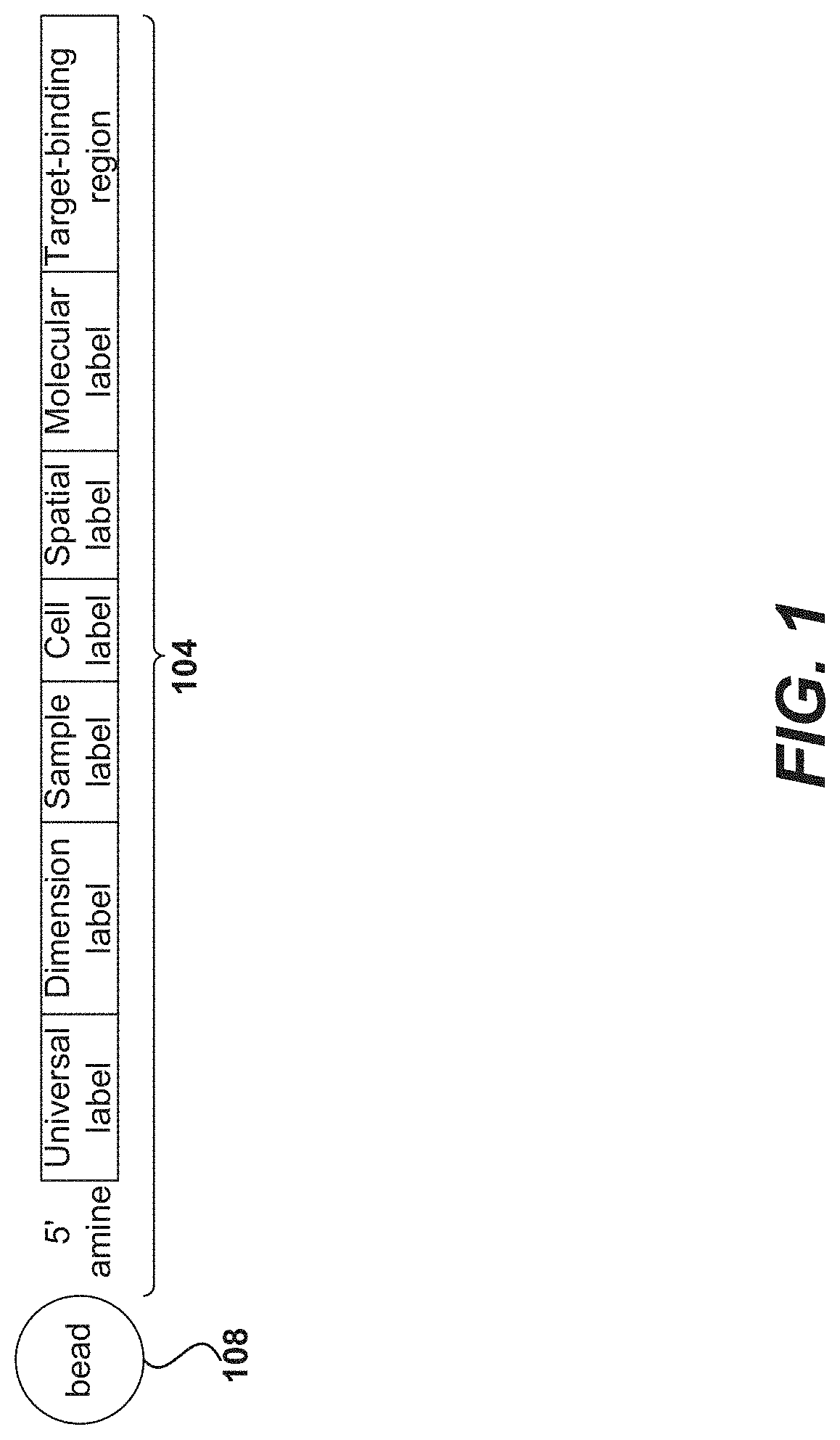Methods and compositions for single cell secretomics
a single cell secretomics and composition technology, applied in the field of molecular biology, can solve problems such as the disruption of synthesized particles
- Summary
- Abstract
- Description
- Claims
- Application Information
AI Technical Summary
Benefits of technology
Problems solved by technology
Method used
Image
Examples
example 1
Oligonucleotides for Associating with Protein Binding Reagents
[0444]This example demonstrates designing of oligonucleotides that can be conjugated with protein binding reagents (e.g., a secreted factor-binding reagents). The oligonucleotides can be used to determine protein expression and gene expression simultaneously. The oligonucleotides can also be used for sample indexing to determine cells of the same or different samples.
95mer Oligonucleotide Design
[0445]The following method was used to generate candidate oligonucleotide sequences and corresponding primer sequences for simultaneous determination of protein expression and gene expression or sample indexing.
[0446]1. Sequence Generation and Elimination
[0447]The following process was used to generate candidate oligonucleotide sequences for simultaneous determination of protein expression and gene expression or sample indexing.
[0448]Step 1a. Randomly generate a number of candidate sequences (50000 sequences) with the desired lengt...
example 2
Oligonucleotide-Associated Antibody Workflow
[0491]This example demonstrates a workflow of using an oligonucleotide-conjugated antibody for determining the expression profile of a protein target.
[0492]Frozen cells (e.g., frozen peripheral blood mononuclear cells (PBMCs)) of a subject are thawed. The thawed cells are stained with an oligonucleotide-conjugated antibody (e.g., an anti-CD4 antibody at 0.06 μg / 100 μl (1:333 dilution of an oligonucleotide-conjugated antibody stock)) at a temperature for a duration (e.g., room temperature for 20 minutes). The oligonucleotide-conjugated antibody is conjugated with 1, 2, or 3 oligonucleotides (“antibody oligonucleotides”). The sequence of the antibody oligonucleotide is shown in FIG. 10. The cells are washed to remove unbound oligonucleotide-conjugated antibody. The cells are optionally stained with Calcein AM (BD (Franklin Lake, N.J.)) and Drag7™ (Abcam (Cambridge, United Kingdom)) for sorting with flow cytometry to obtain cells of interest ...
example 3
Cellular Component-Binding Reagent Oligonucleotides
[0496]FIGS. 11A-11B show non-limiting exemplary designs of oligonucleotides for determining protein expression and gene expression simultaneously and for sample indexing. FIG. 11A shows a non-limiting exemplary cellular component-binding reagent oligonucleotide (SEQ ID NO: 7) comprising a 5′ amino modifier C6 (5AmMC6) linker for antibody conjugation (e.g., can be modified prior to antibody conjugation), a universal PCR handle, an antibody-specific barcode sequence, and a poly(A) tail. While this embodiment depicts a poly(A) tail that is 25 nucleotides long, the length of the poly(A) tail can vary. In some embodiments, the antibody-specific barcode sequence is antibody clone-specific barcode for use in methods of protein expression profiling. In some embodiments, the antibody-specific barcode sequence is a sample tag sequence for use in methods of sample indexing. Exemplary design characteristics of the antibody-specific barcode sequ...
PUM
 Login to View More
Login to View More Abstract
Description
Claims
Application Information
 Login to View More
Login to View More - R&D
- Intellectual Property
- Life Sciences
- Materials
- Tech Scout
- Unparalleled Data Quality
- Higher Quality Content
- 60% Fewer Hallucinations
Browse by: Latest US Patents, China's latest patents, Technical Efficacy Thesaurus, Application Domain, Technology Topic, Popular Technical Reports.
© 2025 PatSnap. All rights reserved.Legal|Privacy policy|Modern Slavery Act Transparency Statement|Sitemap|About US| Contact US: help@patsnap.com



